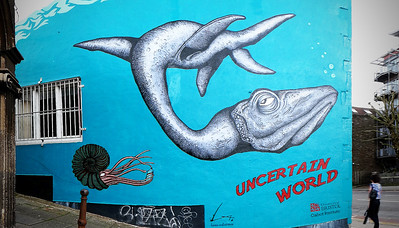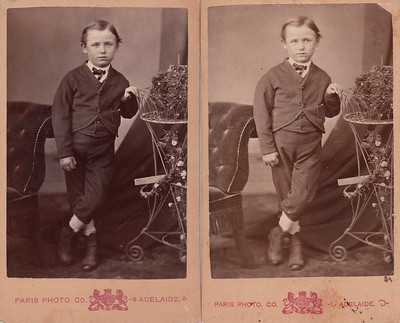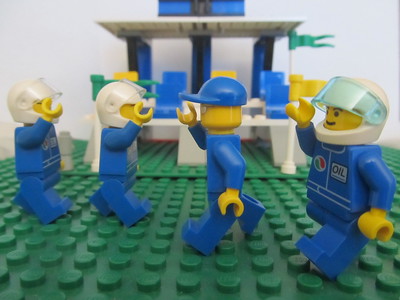Archive for March, 2022
Work Like You Matter
 When you were wrong, the outcome was different than you thought.
When you were wrong, the outcome was different than you thought.
When the outcome was different than you thought, there was uncertainty as the work was new.
When there was uncertainty, you knew there would be learning.
When you were afraid of learning, you were afraid to be wrong.
And when you were afraid to be wrong, you were really afraid about what people would think of you.
Would you rather wall off uncertainty to prevent yourself from being wrong or would you rather try something new?
If there’s a difference between what others think of you and what you think of yourself, whose opinion matters more?
Why does it matter what people think of you?
Why do you let their mattering block you from trying new things?
In the end, hold onto the fact that you matter, especially when you have the courage to be wrong.
“Oh no, what went wrong?” by Bennilover is marked with CC BY-ND 2.0.
When You Don’t Know What To Do…
 When you don’t know what to do, what do you do? This is a difficult question.
When you don’t know what to do, what do you do? This is a difficult question.
Here are some thoughts that may help you figure out what to do when you really don’t know.
Don’t confuse activity with progress.
Gather your two best friends, go off-site, and define the system as it is.
Don’t ask everyone what they think because the Collective’s thoughts will be diffuse, bland, and tired.
Get outside.
Draw a picture of how things work today.
Get a good meal.
Make a graph of goodness over time. If it’s still increasing, do more of what you did last time. If it’s flat, do something else.
Get some exercise.
Don’t judge yourself negatively. This is difficult work.
Get some sleep.
Help someone with their problem. The distraction will keep you out of the way as your mind works on it for you.
Spend time with friends.
Try a new idea at the smallest scale. It will likely lead to a better one. Repeat.
Use your best judgment.
Image credit – Andrew Gustar
Same-But-Different, A Superpower That Can Save The Day
 If there’s one superpower to develop, it’s to learn how to assess a project and get a good feel for when it will launch.
If there’s one superpower to develop, it’s to learn how to assess a project and get a good feel for when it will launch.
When you want to know how long a project will take, ask this simple question: ‘What must the project team learn before the project can launch?” By starting with this single question, you will start the discussion that will lead you to an understanding of what hasn’t been done before and where the uncertainty is hiding. And if there’s one thing that can accelerate a project, it’s defining where the uncertainty is hiding. And knowing this doubly powerful, like a pure two-for-one, because if you know where uncertainty is, by definition, you know where it isn’t. Where the uncertainty isn’t, you can do what you did last time, and because you’ve done it before, you know how long it will take. No new tools, no new methods, no new analyses, no new machines, no new skillsets, no new anything. And for the remaining elements of the project, well, that’s where the uncertainty is hiding and that’s where you will focus on the learning needed to secure the launch.
But it can be difficult to understand the specific learning that must be done for a project to launch. One trick I like to use is the Same-But-Different method. It goes like this. Identify a project that launched (Project A) that’s most similar to the one that will launch next (Project B) and perform a subtraction of sorts. Declare that Project B (the one you want to launch) is the same as Project A (the one you already launched) but different in specific ways and then define those differences as clearly and tightly as possible. And where it’s different, that’s where the learning energy must be concentrated.
Same-But-Different sounds simplistic and trivial, but it isn’t. More than anything, it’s powerful. For the elements that are the same, you do what you did last time, which is freeing. And for the small subset if things that are different, you dig in!
Same-But-Different drives deep clarity and extreme focus, which result in blistering progress and blinding effectiveness.
And for some reason unknown to me, asking a team to define the novel elements of a project is at least fifty times more difficult than asking them how Project B is different than Project A. So, it feels good to the team when they can use Same-But-Different to quickly easily define what’s different and then point directly to the uncertainty. And once the team knows where the uncertainty is hiding, it’s no longer hiding.
And if there’s one thing a project team likes, it’s knowing where the uncertainty is hiding.
“The same, but different by the Paris Photographic Co. (c.1880)” by pellethepoet is marked with CC BY 2.0.
Small Teams are Mighty
 When you want new thinking or rapid progress, create a small team.
When you want new thinking or rapid progress, create a small team.
When you have a small team, they manage the handoffs on their own and help each other.
Small teams hold themselves accountable.
With small teams, one member’s problem becomes everyone’s problem in record time.
Small teams can’t work on more than one project at a time because it’s a small team.
And when a small team works on a single project, progress is rapid.
Small teams use their judgment because they have to.
The judgment of small teams is good because they use it often.
On small teams, team members are loyal to each other and set clear expectations.
Small teams coordinate and phase the work as needed.
With small teams, waiting is reduced because the team members see it immediately.
When something breaks, small teams fix it quickly because the breakage is apparent to all.
The tight connections of a small team are magic.
Small teams are fun.
Small teams are effective.
And small teams are powered by trust.
“LEGO Octan pit crew celebrating High Five Day (held every third Thursday of April)” by Pest15 is marked with CC BY-SA 2.0.
Things I Sometimes Forget
 Clean-sheet designs are fun, right up until they don’t launch.
Clean-sheet designs are fun, right up until they don’t launch.
When you feel the urge to do a clean-sheet design, go home early.
When you don’t know how to make it better, make it worse and do the opposite.
Without trying, there is no way to know if it will work.
Trying sometimes feels like dying.
But without trying, nothing changes.
Agreement is important, but only after the critical decision has been made.
When there’s 100% agreement, you waited too long to make the decision.
When it’s unclear who the customer is, ask “Whose problem will be solved?”
When the value proposition is unclear, ask ‘What problem will be solved?”
When your technology becomes mature, no one wants to believe it.
When everyone believes the technology is mature, you should have started working on the new technology four years ago.
If your projects are slow, blame your decision-making processes.
Two of the most important decisions: which projects to start and which to stop.
All the action happens at the interfaces, but that’s also where two spans of control come together and chafe.
If you want to understand your silos and why they don’t play nicely together, look at the organizational chart.
When a company starts up, the product sets the organizational structure.
Then, once a company is mature, the organizational structure constrains the product.
At the early stages of a project, there’s a lot of uncertainty.
And once the project is complete, there’s a lot of uncertainty.
“Toys Never Forget” by Alyssa L. Miller is marked with CC BY 2.0.
 Mike Shipulski
Mike Shipulski